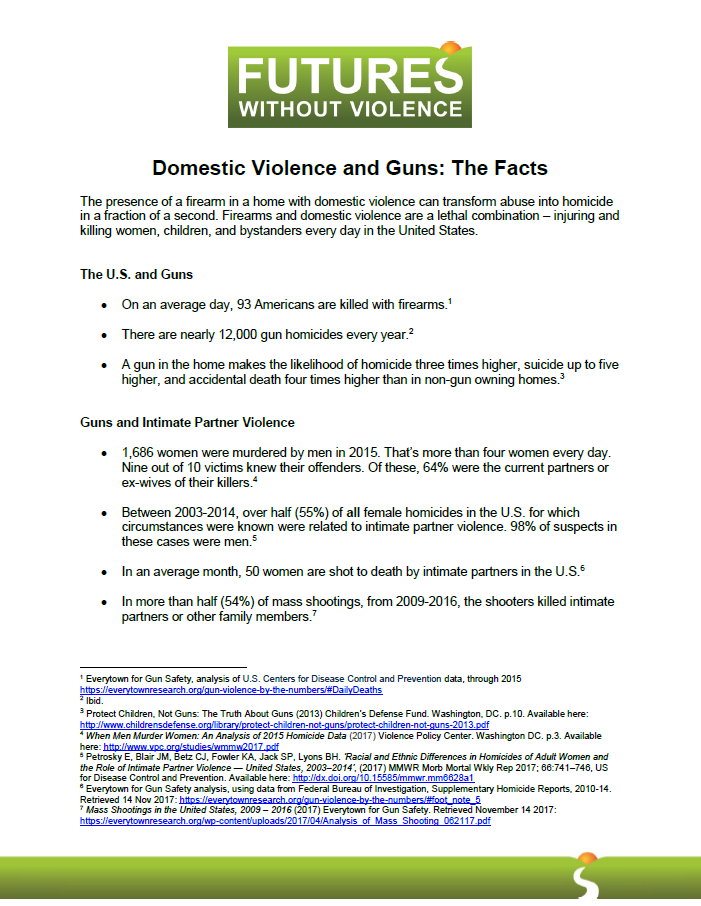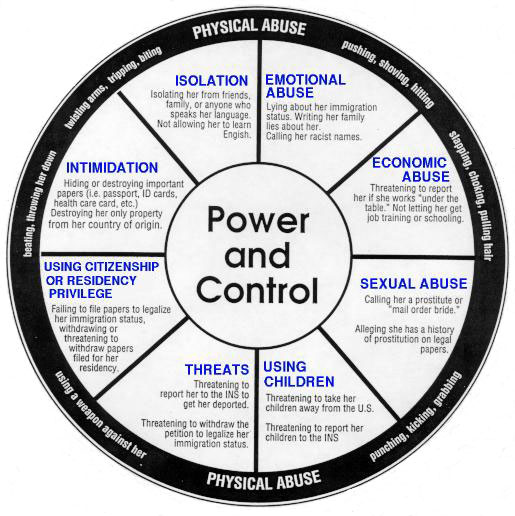Testimony of Futures Without Violence Board member Jacqueline Campbell, PhD, RN, FAAN, the Anna D. Wolf Chair and Professor at the Johns Hopkins University School of Nursing before Senate Judiciary Committee hearing July 30, 2014
Senators, I am grateful for the opportunity to testify in these important hearings today. I will present data from my own research on domestic violence homicide of women, as well as from other important research and national databases on the subject.
The United States has higher a homicide rate of women than all other westernized countries and among the highest rate in the world. This disparity is particularly pronounced for homicides of women committed with guns, in which the country’s rate exceeds by 11 times the average rate in other comparable countries (Hemenway, Shinoda-Tagawa & Miller, 2002; Stockl et al, 2013).
Much of this fatal violence against women is committed by intimate partners. Although neither entirely complete and nor without coding errors, the FBI’s Supplemental Homicide Reports are the most complete national database of homicide with information on the relationship of the perpetrator to the victim. In the most recent data available (2011), at least 45% of the murders of women were committed by a current husband or boyfriend or ex husband. If we only examine the homicides where the perpetrator relationship to the victim was identified, more than half (54.2%) of the homicides of women are committed by a husband, boyfriend of former husband (Violence Policy Center 2013).There were 10 times as many women killed by a current husband or boyfriend or ex-husband (926) as by a male stranger (92).
The majority of this violence is perpetrated with firearms. In the Violence Policy Center analysis of the 2011 murders of women, there were 1,707 females murdered by males in single victim/single offender incidents in 2011. Of those incidents of homicides in which the weapon could be determined (1,551), more of these homicides were committed with firearms (51 percent) than with any other weapon.
Women are also killed by partner or ex-partners when they are pregnant. In an important study of maternal mortality in the state of Maryland from 1993-2008, Dr. Diana Cheng and Dr. Isabelle Horon examined medical records of women who died during the pregnancy and the first postpartum year. Homicides (n=110) were the leading cause of death, and firearms were the most common (61.8%) method of death. A current or former intimate partner was the perpetrator in 54.5% (n= 60) of the homicide deaths and nearly two-thirds of intimate partner homicide victims in their study were killed with guns. In a national study of pregnancy associated homicide, firearms again accounted for the majority of homicides (56.6%) (Chang et al, 2005).
Research my peers and I have conducted provides further insights into how firearm access and domestic abuse elevate the risk of homicide for American women, and explain why existing federal laws restrict certain convicted domestic abusers from buying or possessing guns.
Survey research of battered women indicates that when a firearm is present, a majority of abusers will use the gun to threaten or injure the victim. In a study Susan Sorenson and Douglas Weibe conducted with over 400 women in domestic violence shelters across California, two-thirds of abused women who reported a firearm in their home said their intimate partner used a gun against them, with 71.4% threatening to shoot/kill her and 5.1% actually shooting at her.
Among the most rigorous research available on factors that influence a woman’s likelihood of homicide is the national, 12-city case-control study of intimate partner homicide (husband, boyfriend, ex-husband, ex-boyfriend) conducted by myself and colleagues. In the study we compared a group of abused women who were murdered by their partner or ex-partner to another group of abused women who were not. Controlling for other factors, we found that gun access/ownership increased the risk of homicide over and above prior domestic violence by 5.4 times. Gun access was the strongest risk factor for an abused woman to be killed by her partner or ex-partner. Among perpetrators who committed suicide after killing their abused wife, girlfriend or former wife or girlfriend, gun access was an even stronger risk factor. In those cases, access to a firearm increased the chances of the homicide-suicide by an adjusted odds ratio of 13.
Neither of these studies found evidence that women frequently use firearms to defend themselves against abuse or that access to a firearm reduces the risk of homicide for a woman. In the survey conducted by Sorenson and Wieber, fewer than 1 in 20 abused women that had access to a gun reported having ever used it in self-defense against their abuser (4.5% of the total). And our research showed that for the relatively few women in the study who owned a gun, firearm possession had no statistically significant effect on her risk of being killed by an intimate partner; it neither increased nor decreased her risk.
In leaving out abusive dating partners, current federal firearm prohibitions ignore the perpetrators of a large and growing share of intimate partner homicides. US Department of Justice data shows that the share of domestic violence homicides committed by dating partners has been rising for three decades, and boyfriends now commit more homicides than do spouses. And this data is likely an underestimate because it does not account for homicides committed by ex-boyfriends, which are seldom accurately coded in the Supplemental Homicide Reports. Our national case control data study of 12 cities found approximately 19% of intimate partner homicides are committed by an ex-boyfriend (Campbell, Webster, McFarlane et al, 2003). Estimating from that proportion, approximately 300-500 female intimate partner homicides each year should be added to the approximately 1000 already counted in the Supplemental Homicide Reports. S. 1290, the Protecting Domestic Violence and Stalking Victims Act, would expand our national domestic violence laws to include both former and current dating partners who together represented 48% of the male domestic violence homicide perpetrators in our study, and is therefore an extremely important way to keep women safe and save lives.
There is also evidence that state laws to strengthen firearm prohibitors against domestic abusers reduce intimate partner homicide. In two separate studies — one of 46 of the largest cities in the US (Zeoli and Webster, 2010) and one of at the state level (Vigdor and Mercy, 2006) — researchers found that state statutes restricting those under domestic violence restraining orders from accessing firearms are associated with reductions in intimate partner homicides, driven by a reduction in those committed with firearms. Vigdor and Mercy’s study found that state laws prohibiting firearm possession by people under domestic violence restraining orders (along with entering state domestic violence restraining orders into the federal database) reduced Intimate partner homicide of women by firearms by 12-13%, decreasing overall intimate partner homicide by 10%.
In conclusion, women who suffer abuse are among the most important for society to protect. Congress has an opportunity to do so by strengthening the laws to keep domestic abusers from getting guns. And ample scientific evidence shows that in doing so you will save lives.
I thank you very much for this opportunity to testify about this important legislation that can help save women’s lives.
References:
Bureau of Justice Statistics. Homicide Trends in the United States, 1980-2008. 2011. Washington, DC: Bureau of Justice Statistics. 2011 NCJ 236018
Catalano, S, Smith, E, Snyder, H., & Rand, M. 2009. Female Victims of Violence. Washington, DC: Bureau of Justice Statistics. NCJ 228356
Campbell JC, Webster DW, Koziol-McLain J, et al. Risk factors for femicide in abusive relationships: results from a multisite case control study. American Journal of Public Health 2003;93:1069-97.
Chang J, Berg CJ, Saltzman LE, Herndon J. Homicide: a leading cause of injury deaths among pregnant and postpartum women in the United States, 1991–1999. American Journal of Public Health 2005; 95:471–7.
Cheng, D., Horon, I. Intimate-Partner Homicide Among Pregnant and Postpartum Women. Obstetrics and Gynecology. 2010;115:1181–6.
Hemenway D, Shinoda-Tagawa T, Miller M. Firearm availability and female homicide victimization ratesamong 25 populous high-income countries. Journal of the American Medical Women’s Association 2002; 57(2):100-4.
Sorenson, SB and Wiebe, DJ. Weapons in the lives of battered women. American Journal of Public Health, 2004 94: 1412-1417.
Stöckl, H., Devries, K., Rotstein, A. Abrahams, N., Campbell, J., Watts, C. Garcia-Moreno, C. (2013). The global prevalence of intimate partner homicide. The Lancet. Published online June 20, 2013 http://dx.doi.org/10.1016/S0140-6736(13)61030-2
Vigdor ER, Mercy JA. Do laws restricting access to firearms by domestic violence offenders prevent intimate partner homicide? Evaluation Review 2006; 30:313-46.
Violence Policy Center. When Men Murder Women: An Analysis of 2011 Homicide Data – Females Murdered by Males in Single Victim/Single Offender. www.vpc.org
Zeoli, A. & Webster, D. Effects of domestic violence policies, alcohol taxes and police staffing levels on intimate partner homicide in large US cities. Injury Prevention 2010;16:90-95. doi:10.1136/ip.2009.024620


















